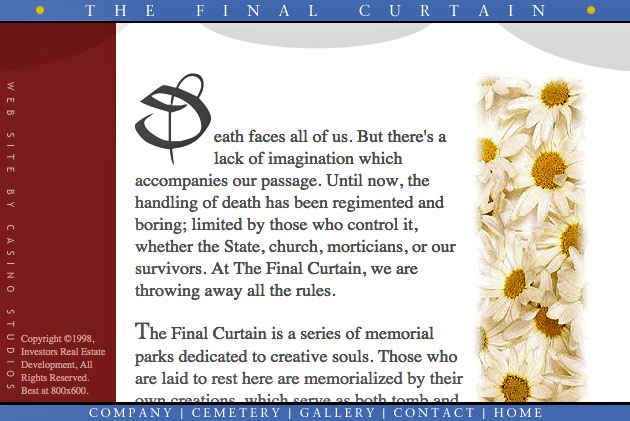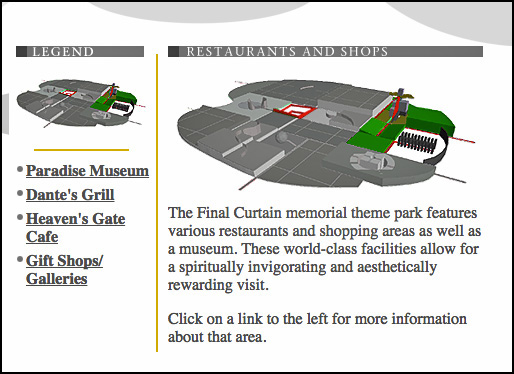Joey Skaggs > Works > 1998, 1999, 2000 > Final Curtain

Final Curtain
Year: 1998, 1999, 2000
Categories: Lifestyle | Culture, Religion, Science | Technology
Overview:
Are you prepared for the inevitable?
How do you want to be remembered?
What can you do about it?
The Final Curtain was an over-the-top parody of the death care industry, designed to provoke people to think about their feelings about life, death and burial in a new light.
To Joey Skaggs, the death care industry is a giant corporate scam, exquisitely successful at commercializing death. Pre-need insurance, embalming services, open coffins, headstones, ground space, religious sanctity, and ancillary products are merchandized to con people into spending money under the premise that this is the right thing to do either from a cultural or religious perspective.
Using calculated public relations and marketing tactics, death care providers have elevated spiritual reverence in the funeral parlor to a high art. Their ploy is to appear to pay appropriate tribute to the dead, making a good show for the mourners. Ultimately, it’s a waste of space and resources, and a burden to the natural environment at the financial and emotional expense of their clients.
In 1998, Skaggs put together a volunteer international team writers, artists, and designers to create The Final Curtain, a website purporting to represent a voracious real estate development company, featuring a Disney-like memorial theme park and mall which included a traveling time share program for the deceased.
The Final Curtain catered to creative individuals (visual artists, poets, performers, etc.) who wanted to construct their own iconoclastic, irreverent, and/or humorous monuments, mausoleums, and urns.
Skaggs sent out press announcements and placed classified ads in numerous newspapers across the country which said, “Death got you down? At last an alternative: www.finalcurtain.com.” This led the press and public to the website.
There they found an elaborate company site complete with a business plan, architectural renderings and actual designs for artists’ memorials created by Skaggs’ co-conspirators.
To see more memorials, visit http://finalcurtain.com–>Gallery–>Monument Gallery.
The parks, planned to be franchised in major metropolitan cities around the world and open to the public, would be a haven for those who wished to be free of the shackles of the current death-care industry’s morbid grip on life’s passing.
The Final Curtain memorial theme park concept was so outrageous, yet so plausible, that it was widely reported in newspapers and magazines, and on television, radio and the internet, without question. The public both embraced and attacked it.
Venture capitalists expressed interest in investing. The States of Colorado and New Jersey threatened investigation into the illegal sales of securities on the Internet. A corporation threatened legal action for trademark infringement. Television and Hollywood movies were proposed. And artists submitted burial concepts hoping to be selected by the company for a free grave site.
Joey Skaggs perpetuated the virtual burial business by setting up a bogus office with a telephone and an answering machine and responding to the barrage of requests for interviews. That he played all the parts of the company’s executives during interviews, i.e., Managing Director Michael Varley; Marketing Director Stuart MacLelland; and Associate Marketing Director Paul Corey, did not deter a single journalist.
He talked about the artist-designed adventure rides such as the “roller coaster of life and death,” and the interactive playgrounds where children would frolic on artists’ grave sites. He described the shops that sold mausoleum replica key chains and coffee mugs.
The Final Curtain was, for all intents and purposes, a real amusement park for the dead. Funeral directors were all for it. They oozed delight that at last big investment money was helping to merge the death care industry into the entertainment world.
Skaggs always leaves clues in his performances. In this case, his own monument, mounted in the Monument Gallery, under the name of Joseph Sullivan, was a screen animation of Skaggs morphing from flesh to bone, with a worm crawling in one eye and out of his mouth.
Post script:
In November of 2009, five months after the death of Michael Jackson, Joey Skaggs began receiving inquiries from Jackson fans. Jackson had said “This is it. This is the final curtain call” during his press conference for the upcoming “This is it” tour. The fact that Joey Skaggs had perpetrated The Final Curtain hoax years earlier, and the fact that Michael Jackson passed away after saying those words, seemed to convince people that Joey Skaggs and Michael Jackson had conspired to fake Jackson’s death. Many people believed Michael Jackson was not dead, but that Skaggs had helped him create the “Michael Jackson Death Hoax” so he could disappear. They implored Skaggs to reveal where Michael Jackson was. The demand became such that Skaggs posted a notice on his Facebook page, hoping to quell the concerns. But to this day, he still receives frequent inquiries about Michael Jackson’s whereabouts.
Hook:
Line:
- Off-Kilter: Go Out With a Bang--Cutting-Edge Tombstones in Theme-Park Setting, by Roy Rivenburg, Los Angeles Times, October 11, 1999
- Theme Park to be Disneyland for the Dead, Wireless News Flash, October 7, 1999
- Final Curtain unearths new cemetery concept, by Joel Brown, Boston Sunday Herald, October 17, 1999
- The Off-Kilter: Meanwhile, Back on the Vivarium, by Roy Rivenburg, Los Angeles Times, October 22, 1999
- Some dying to get into cemetery theme parks, by Brian Hicks, Post & Courier, October 24, 1999
- Unusual memorials suggested for parks, The Augusta Chronicle, October 25, 1999
- Beyond the Grave: E-Commerce Crosses Into the Next World, by Jeff Howe, Village Voice, November 9, 1999
- Firms Slap on the Y2K and push out the product, by Rona Kobell, Pittsburgh Post Gazette, December 7, 1999
- Daily Features: The theme park that makes sure you have the last laugh, The Daily Telegraph, December 8, 1999
- Buying time: Year-2000 madness has firms cashing in, by Rona Kobell, The Washington Times, December 13, 1999
- Putting the Fun back in Funeral, by Jonathan Durbin, Paper, December 1999
- Bulldada Bazarre: More Fun at Funeral Parks, by Rebecca Bengal, Eye, January, 2000
- Pretty Strange Sites: Celebrating Death, by Scott Alexander, ZDNet, January 31, 2000
- Theme Park: Death by Design, Timeshares for the Deceased, Landscape Architecture, January 2000
- News of the Weird: Memorial land, by Chuck Shepard, Star Tribune, January 2, 2000
- Ashes-to-Ashes Can Mean More Than a Nice Little Urn, by Gavin Bell, Scotsman, January 7, 2000
- The Weird and Wacky on the Internet: The Final Curtain, by Scott Alexander, Yahoo Internet Life, February 2000
- Deathwatch 2000: Do Not Go Gentle Into The Good Night, edited by Tim Dickinson and Alastair Paulin, Mother Jones, March 2000
- Bizarre Website of the Month, Jane, March 2000
- The Art of Death in New Jersey, Gallery, April 2000
- Ideas & Opinions: Grave Misgivings, by Lenore Skenazy, New York Daily News, May 14, 2000
Sinker:
- Final Curtain exposé press release
- Web Prank Turns Up DOA, by Lynn Burke, Wired, May 19, 2000
- Hoax in the machine, by Angela Gunn, Seattle Weekly, May 25, 2000
- The Arts: Pranks and Beans, by Doug Harvey, LA Weekly, May 26, 2000
- Prank reminds users not to take Net at face value, Boston Sunday Herald, May 28, 2000
- Stupid Death Tricks, by Jeff Stark, Salon.com, May 31, 2000
- Cyberlinks: Look who's behind the Final Curtain, by Patti Hartigan, Boston Globe, June 2, 2000
- Urban Elf Report: Rocking the Status Quo, by Saint Reverend Jen Miller, Shout, August, 2000
- Deathwatch 2000: Do Not Go Gentle Into The Good Night, edited by Tim Dickinson and Alastair Paulin, Mother Jones, March 2000
- Notebook: The Final Curtain, Brill's Content, April, 2001
- Forum: Death Got You Down?, Archaeology, May 2001
- Media Hoaxer Joey Skaggs Strikes Again, by John Elvin, Insight, June 3, 2002
- Psych 101: The Final Curtain, Yahoo Internet Life, July 2002
- Hoaxes without end: An Interview with Joey Skaggs, by Paul Maliszewski, McSweeney's, 2002



